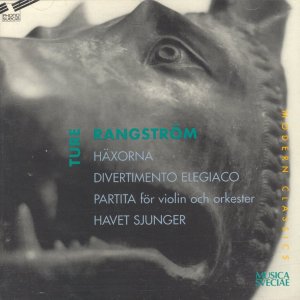Rangström's
natural leaning was towards song and poetry. Of course there are
four symphonies (of which the most memorable is the Third - well
presented on both Sterling and CPO) but even these bear links
with his vocal tradition. This disc has one song cycle for soprano
and orchestra and three orchestral works. Both Häxorna
(The Witches) and Den Utvolda (The Chosen
One) were conceived for voice and orchestra rather than being
written for voice and piano and then orchestrated. Häxorna
sets poems by Erik Abel Karlfeldt. The subject is the Wicca world
of spirits, libidinous spirits, things that fly and skitter in
the depths of the night. Whether in the breathy tolling of the
Walk not amidst guelder rose and sloes or the 'peg-leg'
rhythm of Dance in a Plantain field Rangström summons
a world of homunculi, nocturnal schemes, eldritch consummations
and witchery. The final song, which runs to over seven minutes,
adroitly catches a strange mood-scene
Far
far away on the heath of heaths
You'll
sit in a desolate Eden
As
endless earth-suns rise and set
Nor
aeons nor years are yours
Withering
fast, you shall heavy climb ...
Karin
Ingebäck sings with steady tone and is alive to the very
unusual fantasy of this piece which can be read with Paul Schierbeck's
Häxä and Dies Irae. The music is typical
of the Scandinavian romantic scena but with the magical element
ringing some idiosyncratic changes.
After
such weird adventures we come to the placid Divertimento
Elegiaco of 1918 which sounds like a psychologically more
involved development of Grieg's music for strings (Holberg
and Last Spring). The wistful scherzo would run well
with Elgar's Serenade or Introduction and Allegro.
This is the oldest recording here but the Swedish Radio strings
sound silkily healthy.
The
four movement Partita for violin and orchestra is
predominantly neo-classical. This is a style, if not purged of
neo-romantic feeling, certainly one that gives eminence to the
back-to-Bach trend. Rangström seems to have made a deeper
study of Bach scores during the early 1930s. The music finds 20th
century parallels with Bach's suites without their harmonious
quick badinage. The movements are Preambule, Menuett,
Air and Gaillarde.
Song
of the Sea is from 1913, separated from the Divertimento
Elegiaco by a world war. It was written during the summer
of that year in the fishing village of Harstena on the Östergötland
archipelago. The sea is dusky and oleaginously threatening at
first. The work is densely orchestrated and the orchestra is a
Straussian one including four bassoons, six French horns, four
trumpets and four trombones similar to the orchestra used by Alfvén
in his Fourth Symphony. There is oppressive alarm, doom and catastrophe
in this writing. While the atmosphere can be cut with a large
and jagged knife the melodic material is not cut from the finest
cloth until we get to the steadily unfolding theme at 7.07. Even
this with its repetition of flame-curling higher woodwind is more
atmospheric than dramatically potent. There is a Sibelian bleakness
to the brass writing (8.43) and the chanting ostinato at 9.23
is persistent, like a fast moving swell. The piece was quarried
by Rangström for his Third Symphony Song Under The Stars
in 1929. The whole piece has a hypnotic manner and mood continuum
varied only by the wide stretching theme at 0705. In the year
of completing this piece Rangström bought himself a sailing
boat that was to be his lifelong companion. I hope it is not too
fanciful to imagine the weekend sailor's mesmerised reflection
on the water clipped and shorn by the speeding wind-driven keel.
There is a strong implication of film music inherent in this music.
It is easy to imagine Bernard Herrmann championing this music
for it has the vivid communicative quality of Raff's Lenore
and Philip Sainton's The Island.
Rob
Barnett
